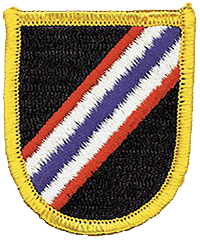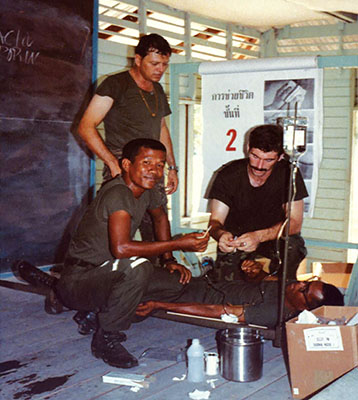DOWNLOAD
In March 2017, while preparing for the visit of Lieutenant General (LTG) Sirichai Tesana, Commanding General of the Royal Thai Special Warfare Command in Lopburi, Thailand, staff members discovered that the general’s father had graduated from the U.S. Army Special Forces Qualification Course (SFQC) almost sixty years earlier. On notification of the visit, the USASOC History Office conducted some research into that class and located others who had gone through the course with then-First Lieutenant Sri Tesana. It became apparent that the class was a special one as a number of its students went on to exert great influence in SOF circles for years to come. One fellow graduate, Colonel (COL) (Retired) Jerry M. King, provided the Office with his personal class photo and shared stories of the course and its attendees.1 That information was used to create a packet to give to LTG Tesana that commemorated his father’s SFQC experience.
The History Office created a high-resolution photo of LTG Tesana’s father’s SF ‘Q’ Course photo and a reproduction graduation certificate. The photo and certificate were presented to the general during his visit, adding a deeply appreciated personal touch to the occasion. In addition, Dr. Jared M. Tracy from the History Office provided a brief on the Memorial Plaza. The visit was a big success.
Separately, the leadership of the 3rd Battalion, 1st Special Forces Group was also keen to show its appreciation for COL Tesana’s shared service and the close relationship between their unit and Thai Special Forces. They put together a diplay case and acquired a Yarborough Knife for presentation to retired COL Tesana recognizing the more than sixty years of brotherhood with Thai Special Forces. That generational bond was symbolized by COL Tesana’s attendance of SFQC early in his career, his son’s command, and continues an SF tradition. Over those years, thousands of American and Thai Special Forces soldiers have worked side-by-side in the field and shared skills and experiences.
46th SF Company and the Royal Thai Army

U.S. Army Special Forces has a long history of close relations with the Royal Thai Army (RTA), and in particular, with the RTA Special Forces. These two elite military organizations share more than a half century of close and continuous training, education, and operations. Although TDY Military Training Teams (MTTs) and deployments for training (DFTs) to Thailand occurred as early as the late 1950s, a milestone in this relationship took place on 15 April 1966 when the U.S. Continental Army Command (CONARC), the predecessor of today’s Forces Command (FORSCOM) and Training and Doctrine Command (TRADOC), formed Company D, 1st Special Forces Group.6

CONARC established Company D to provide a permanent SF presence in Thailand to train RTA units in counterinsurgency tactics and procedures. After a few months of mission preparation at Fort Bragg, NC, the majority of the 369-man company boarded C-141 aircraft and arrived in Thailand on 15 October 1966. By November, detachments had been dispersed to select RTA units throughout the country to teach five-week courses in basic counterinsurgency techniques. The program was very effective. Less than five days after one of the initial Thai companies finished its training, that unit successfully defeated an insurgent element in the field.7 In addition, on 9 January 1967 the company began training select RTA soldiers to cadre the first Special Forces Proficiency Course, the start of a long tradition with Thai SF soldiers.
On 10 April 1967, U.S. Army, Pacific (USARPAC) deactivated Company D and activated an independent 46th SF Special Forces Company under U.S. Military Assistance Command, Thailand.8 By September 1967, soldiers of the 46th Company had trained over 7,000 RTA soldiers. In addition, the 46th Company prepared the first RTA contingent for service in Vietnam (Task Force SLICK).9

Training continued unabated for the next seven years. However, as part of the theater-wide Southeast Asia troop drawdown associated with Vietnamization, USARPAC inactivated the 46th SF Company on 31 March 1972. Concurrently, 46th Company personnel and equipment were assigned to the 3rd Battalion, 1st Special Forces Group.10 The circle was complete: what began as a 1st SFG element in 1967 officially returned to the Group.11
Although it did not maintain a permanent presence in the Kingdom, RTA and American Special Forces soldiers continued their close relationship through MTTs and DFTs. By working side-by-side with the RTA, old friendships are preserved and new ones begun. The groundwork of mutual respect and cooperation established by the 46th SF Company a half century ago continues to flourish.
A Unique Special Forces Officers Course
Class 33-G-F3, 2-60
19 January — 1 March 1960
This class photo was taken at a time in Special Forces training history when officer and enlisted trained separately. Despite this practice, the prevailing attitude was “you must be at least a three time volunteer to be a good Special Forces soldier: volunteer for the Army, volunteer for airborne, and volunteer for Special Forces.”2 Much to the dismay of many Regular Army commanders, Special Regulation (SR) 600-160-10, “Personnel, Volunteers for Special Forces Units,” published on 25 April 1952, prompted many of their best soldiers to volunteer for Special Forces training and duty. After graduation, these SF soldiers deployed overseas to assist U.S. allies. Those countries reciprocated by sending their best and brightest officers to the Special Forces course at Fort Bragg, North Carolina. Among those who attended was then-First Lieutenant (1LT) Sri Tesana who retired as a Colonel in the Royal Thai Army.
